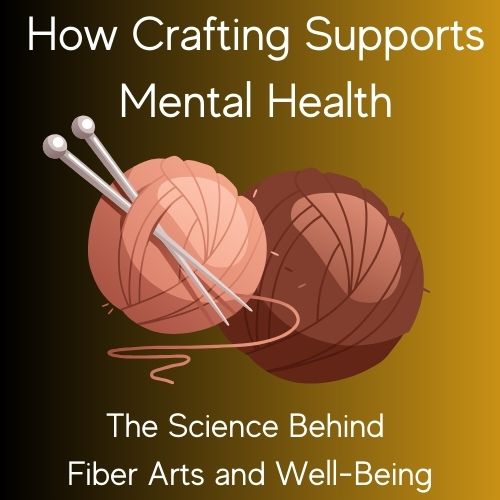I have always known, deep in my bones, that craft is healing. When I wrote Crochet Saved My Life, I shared my personal journey of how crochet helped pull me out of a deep depression. At the time, I was relying on my own experience and the stories of others who had found solace in fiber arts. But when I began researching the book more than a decade ago, I was surprised by how little scientific research existed on the connection between crafting and mental health.
Thankfully, that has changed. In the years since, researchers have started to explore what many of us have known all along—fiber arts are profoundly therapeutic. Crafting is not just a hobby; it is a powerful tool for reducing stress, calming anxiety, improving focus, and even alleviating symptoms of depression and PTSD. I’m honored that my own work has contributed to this growing body of research, and I’m thrilled that more people are recognizing the immense value of creativity for mental well-being.
Explore this in more depth by joining my Craft to Heal workshop.
The Science Behind Crafting for Mental Health
We know that creative expression is beneficial for emotional well-being, but why does crafting specifically help with mental health? Research shows that fiber arts—crochet, knitting, embroidery, quilting, weaving, and other textile crafts—engage the brain in unique ways that support relaxation, mindfulness, and emotional regulation.
1. Crafting Lowers Stress and Anxiety
- The repetitive motions of fiber arts activate the parasympathetic nervous system, which helps calm the body’s stress response.
- Studies have found that knitting can induce a meditative state, reducing heart rate and blood pressure while decreasing cortisol levels (the stress hormone).
- Research suggests that crafting can have effects similar to meditation, helping to ease symptoms of anxiety.
2. Crafting Increases Dopamine and Boosts Mood
- Engaging in creative activities releases dopamine, the brain’s feel-good neurotransmitter.
- Studies indicate that people who engaged in creative activities felt a significant boost in mood the next day.
- Making something with your hands provides a sense of accomplishment and progress, which is especially valuable for those struggling with depression.
3. Fiber Arts Help With Focus and Mindfulness
- Mindful crafting allows makers to enter a “flow state,” where they are fully immersed in the present moment.
- The sensory experience of working with fiber—feeling the yarn, watching stitches form, hearing the soft sound of needles clicking—keeps the mind engaged in a calming, repetitive rhythm.
- For those who struggle with racing thoughts or attention difficulties, crafting provides a structured yet soothing way to stay present.
4. Crafting Helps With Trauma Recovery
- Fiber arts have been used in art therapy programs for individuals coping with PTSD, grief, and emotional trauma.
- Studies show that knitting and weaving help improve emotional regulation, providing a non-verbal way to process difficult emotions.
- Textile crafts offer a safe, tactile outlet for self-expression, allowing people to process feelings through their hands when words are not enough.
5. Creative Community Supports Mental Health
- Research has shown that participating in craft groups reduces loneliness and increases feelings of belonging.
- The social connections built through fiber arts communities provide support, accountability, and encouragement.
- Many people find that crafting in a group creates a sense of shared purpose and healing, whether in-person or online.
Why Fiber Arts? The Unique Benefits of Hands-On Making

Not all creative activities provide the same level of calm and engagement as fiber arts. What makes crochet, knitting, embroidery, quilting, and other textile crafts uniquely beneficial?
✔ Portable & Accessible: Unlike painting or sculpture, many fiber arts can be done almost anywhere, making them easy to integrate into daily life.
✔ Tactile & Sensory: The physical texture of yarn, thread, and fabric provides soothing sensory input, which can be grounding for those with anxiety or sensory processing challenges.
✔ Rhythmic & Repetitive: Unlike other forms of creativity that require constant decision-making, many fiber arts involve repeating patterns, which induce relaxation.
✔ Non-Digital & Screen-Free: In a world dominated by screens, fiber arts offer a much-needed break from technology, reducing eye strain and promoting better sleep.
✔ Productive & Meaningful: Unlike passive relaxation techniques, crafting allows makers to create something tangible, which fosters a sense of purpose and achievement.
Bringing This Into Your Life: How to Use Craft for Mental Health
If you want to start using your craft as a tool for healing and stress relief, here are a few ways to begin:
- Practice Micro-Moments of Crafting: Even just five minutes of stitching, knitting, or crocheting can provide a reset for your nervous system.
- Make It a Ritual: Set aside a few minutes each day to create, even if it’s just one row, one stitch, or one detail.
- Engage in a Mindful Crafting Exercise: Try focusing on one sense at a time while crafting—how the yarn feels, the sound of the needle, the color of the fabric.
- Join a Creative Community: Whether in person or online, crafting in community amplifies its healing effects.
- Use Your Craft to Give Back: Making for others—whether through charity crafting or meaningful gifts—adds another layer of purpose and fulfillment to your practice.
I go over all of these in more depth in the Craft to Heal workshops, providing specific exercises for guidance.
Explore This Deeper in Craft to Heal
Understanding the science behind crafting and mental health is powerful—but experiencing it firsthand is even more transformative. That’s what Craft to Heal is all about.
This year-long workshop series is designed to help you:
- Use fiber arts as a tool for mindfulness, healing, and personal growth.
- Explore creative exercises that deepen your connection to craft and self-care.
- Find community with others who believe in the power of creativity for well-being.
Each month, we dive into a new theme—from mindful making to creative resilience, from community crafting to using art for self-discovery. You can join anytime, and your first class is just $5.
🧶 Want to learn more? Click here to join Craft to Heal.
Craft Is More Than a Hobby—It’s a Lifeline

When I wrote Crochet Saved My Life, I knew that fiber arts had saved me. Over the years, I’ve heard from countless others who have had similar experiences—people who found healing, connection, and purpose through making.
Now, science is catching up with what so many of us have always known: Crafting is good for the mind, body, and soul.
Whether you pick up your hook, needles, embroidery hoop, or quilting frame today—know that you are doing more than making something beautiful. You are caring for yourself. You are healing. You are creating space for joy and calm in a chaotic world.
And if you want to explore this journey more deeply, Craft to Heal is here for you.
